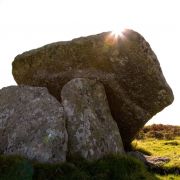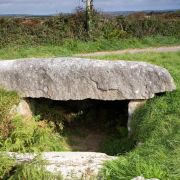Chapel Carn Brea - Entrance Grave
From the brow of Britain’s westernmost hill the sea is only a number of fields away on three sides and the commanding view of the surrounding area and the distant Scilly Isles makes it unsurprising that this prominent hill has played an important role in the area since the Neolithic Age, although it is named after a medieval chapel which stood here.
Chapel Carn Brea is riddled with remains of barrows (it is believed that there were originally over ten) and considered to be connected to other ancient burial sites along the coast from Lands End to St Just. Of the original barrows, there are two of particular note: an entrance grave on the brow of the hill from the late Neolithic period and of a type only found in Penwith and Scilly, and another older specimen, a long barrow dating from the early Neolithic period. The entrance grave, with its long chamber and two capstones, would have been covered by an imposing mound measuring over 60’ in diameter and 16’ in height. In the Bronze Age, two stone chambers (cists) were added above the original grave and, when excavated in the C19th, were found to contain burial remains. To the west of this cairn, the earlier long barrow is a long mound of granite rocks.
The chapel of this hill’s name was erected on top of the entrance grave in the C13th: a hermitage dedicated to St Michael of Brae which had been reduced to rubble by the early C19th. A beacon was also lit on the summit, maintained by hermits using the chapel, which served to guide travellers on sea and land and could also have been used to communicate (beacons were used to inform London of the arrival of the Spanish Armada, for example). The beacon is still lit every Midsummer’s Eve to celebrate the solstice, starting a series of beacon lightings across the county.
The geographical significance of Chapel Carn Brea continues and the C20th witnessed further construction on the site of the summit barrow in the shape of a military observation post for WWII.








